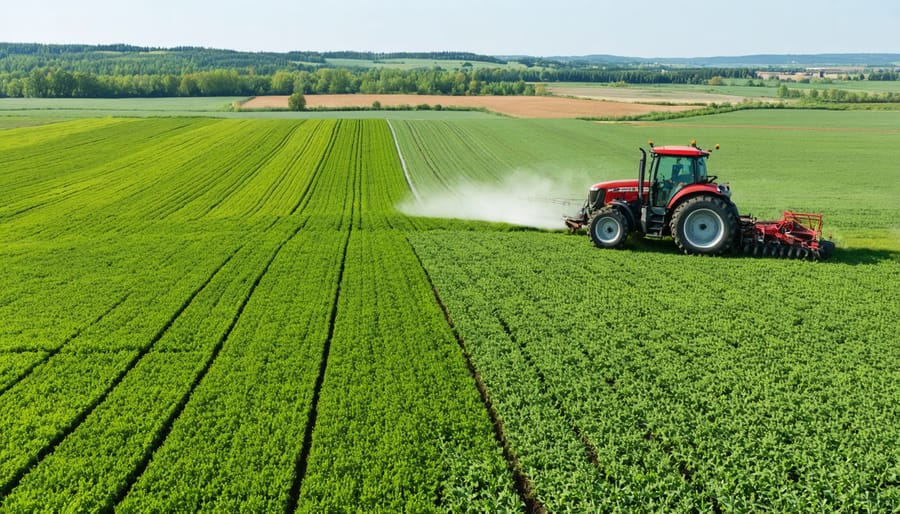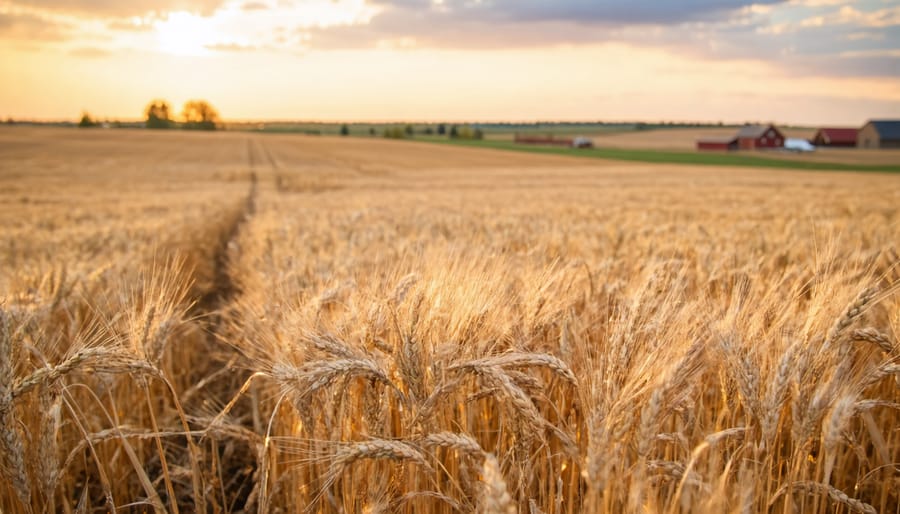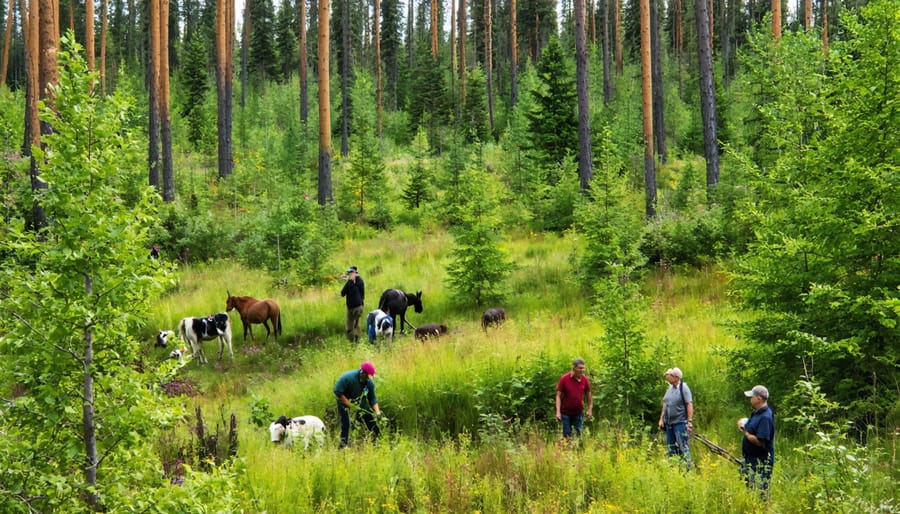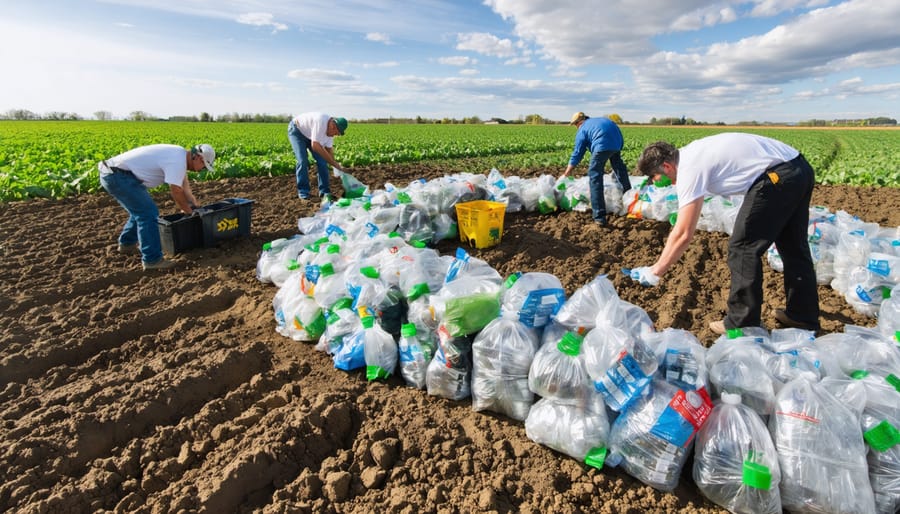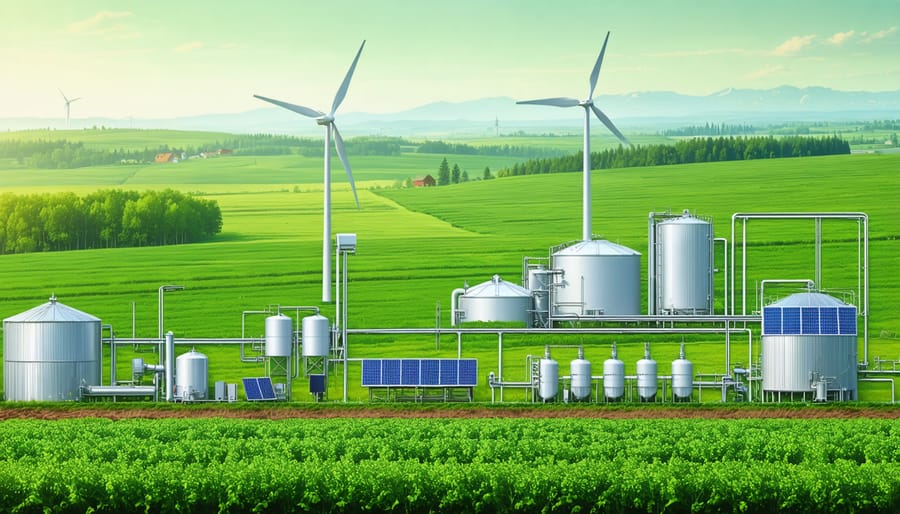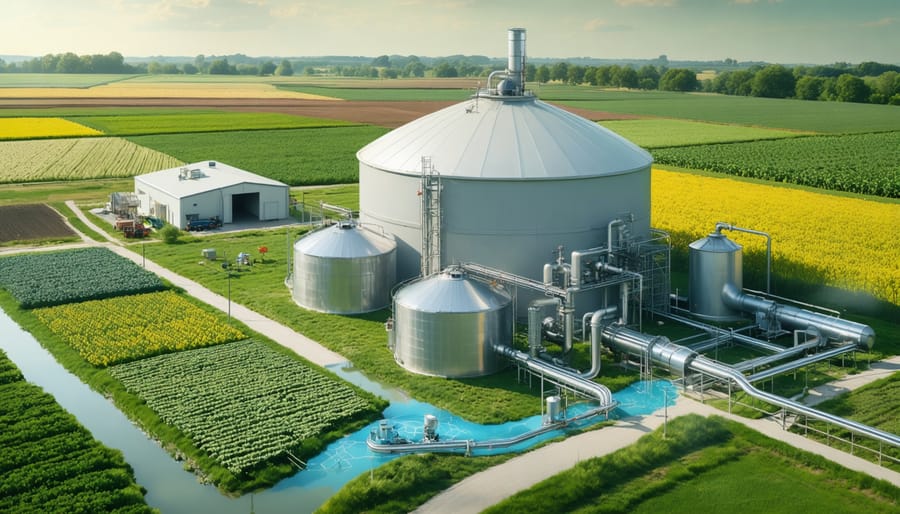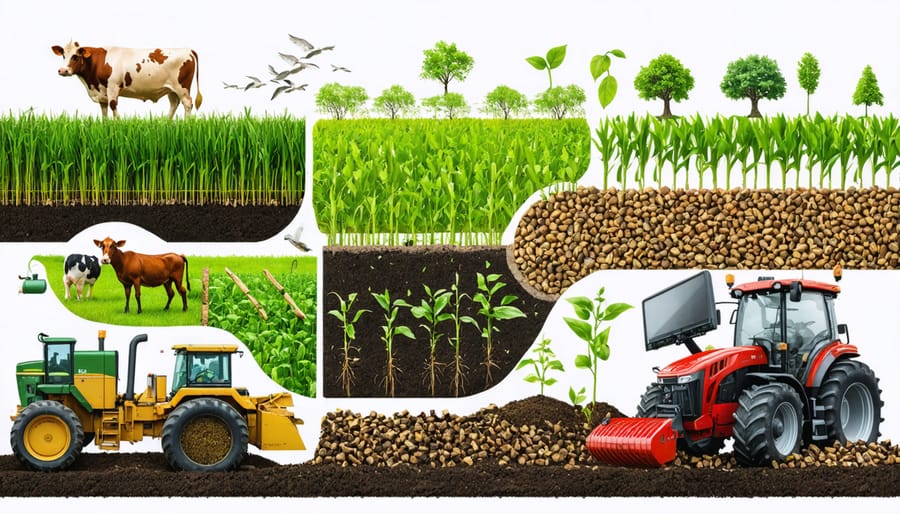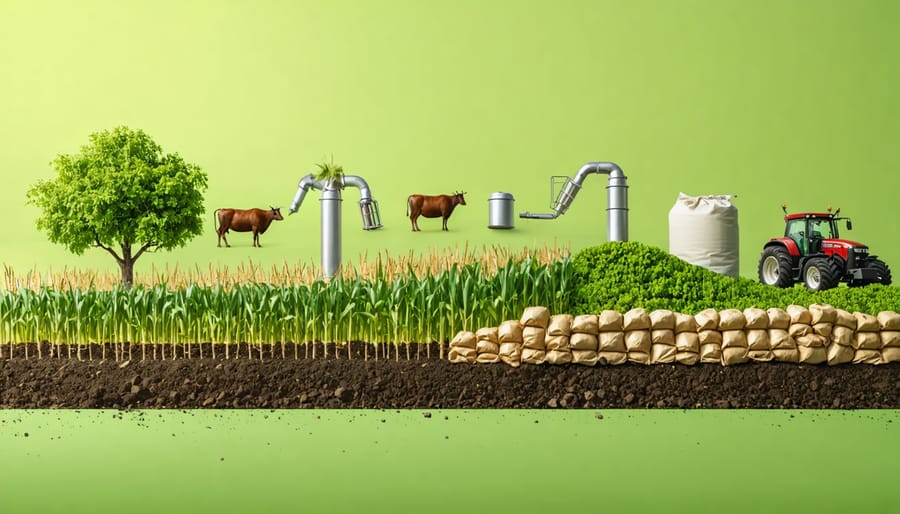Transform agricultural waste into a powerful soil enhancer by converting crop residues and woody materials into biochar – a stable carbon compound that’s revolutionizing approaches to building healthier soil. This ancient practice, rediscovered for modern agriculture, offers Canadian farmers a sustainable solution for both waste management and soil improvement. Field trials across Alberta demonstrate biochar’s ability to increase water retention by up to 30%, boost crop yields by 10-20%, and sequester carbon for centuries. When combined with existing fertilizer programs, biochar creates a powerful foundation for regenerative farming practices that benefit both the environment and the bottom line. Unlike traditional amendments that decompose quickly, biochar’s porous structure provides a permanent habitat for beneficial microorganisms while improving soil structure for generations to come.
How Biochar Revolutionizes Alberta’s Farm Soil
Soil Structure Enhancement
Biochar significantly enhances soil structure by creating a complex network of microscopic pores that improve both soil aeration and water retention. When mixed into Alberta’s diverse soil types, biochar particles form stable aggregates with existing soil particles, creating spaces that range from 2 to 50 micrometres in diameter. These pores act like tiny reservoirs, holding water and nutrients while allowing roots to access them easily.
In our prairie conditions, biochar’s porous structure can increase water holding capacity by up to 20%, meaning less irrigation and better drought resistance. Local farmers report that fields amended with biochar maintain moisture longer during dry spells and drain more effectively during heavy rains, creating ideal growing conditions for crops.
The enhanced soil structure also provides a comfortable habitat for beneficial microorganisms and earthworms, which further improve soil quality. During field trials in Central Alberta, farmers noticed improved soil workability and reduced compaction in their biochar-amended fields, making it easier to prepare seedbeds and allowing for better root development.
For optimal results, we recommend incorporating biochar at a rate of 10-20 tonnes per hectare, mixed thoroughly into the top 15-20 centimetres of soil.
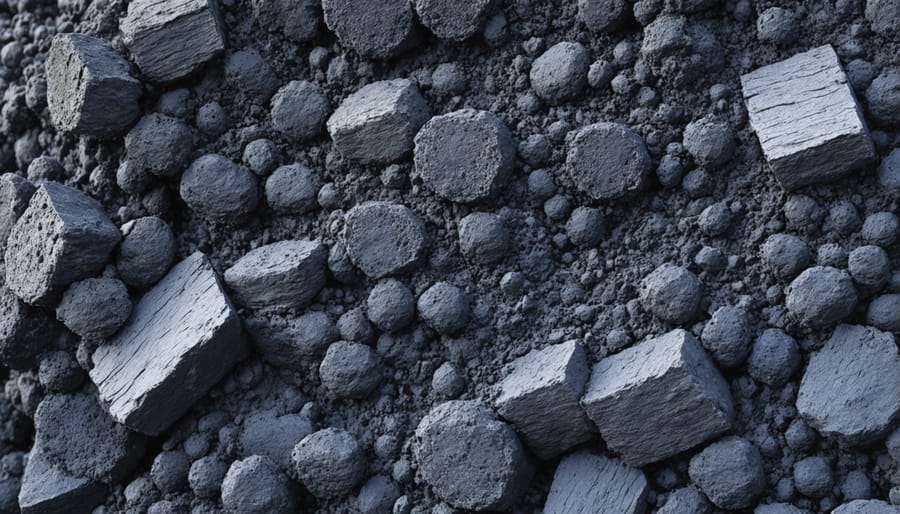
Nutrient Management Benefits
Biochar’s remarkable ability to enhance nutrient management makes it a valuable component of sustainable fertilizer practices across Alberta’s diverse agricultural landscape. When incorporated into soil, biochar acts like a sponge, effectively holding onto essential nutrients that would otherwise leach away during rainfall or irrigation.
The porous structure of biochar creates a vast network of microscopic spaces that trap and store nutrients, particularly nitrogen and phosphorus. This retention capability means farmers can reduce fertilizer applications by 20-30% while maintaining crop yields. For example, Prairie farmers using biochar have reported significant improvements in nutrient efficiency, especially in sandy soils where nutrient loss traditionally poses challenges.
Beyond retention, biochar also enhances nutrient availability by providing a favorable habitat for beneficial soil microorganisms. These microbes help convert bound nutrients into forms that plants can readily absorb. The material’s high surface area and stable carbon structure continue providing these benefits for several growing seasons, making it a long-term investment in soil health and fertility management.
Making Biochar Work on Your Farm
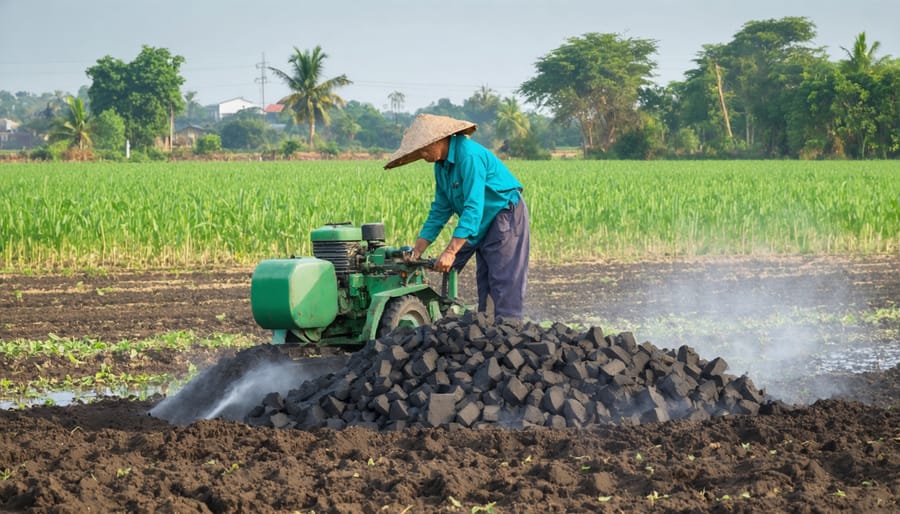
Application Rates and Timing
For Alberta’s clay-heavy soils, start with an application rate of 5-10 tonnes per hectare. Sandy soils benefit from higher rates of 10-15 tonnes per hectare, as they require more organic matter for moisture retention. When first incorporating biochar, apply it during spring preparation or fall cultivation, working it into the top 15-20 cm of soil.
For grain crops like wheat and barley, apply biochar at least two weeks before seeding to allow proper soil integration. Canola fields show best results with fall application, giving the biochar time to stabilize over winter. For root vegetables and pulse crops, incorporate biochar during field preparation at 8-12 tonnes per hectare.
In market gardens and specialty crop operations, increase rates to 15-20 tonnes per hectare, particularly for high-value crops like herbs and vegetables. For perennial crops such as fruit trees and berry bushes, apply biochar at planting time at 2-3 kg per planting hole.
Monitor soil pH after application, as biochar can temporarily increase alkalinity. In acidic soils common in central Alberta’s forest regions, this effect is beneficial. For alkaline soils in southern Alberta, consider reducing application rates and combining with sulfur amendments if needed.
For optimal results, charge the biochar with nutrients before application by soaking it in liquid manure or compost tea for 24 hours. This practice ensures immediate benefits while the long-term soil structure improvements develop.
Integration with Existing Farm Practices
Integrating biochar into existing farm operations doesn’t require a complete overhaul of your current practices. Many Alberta farmers have successfully incorporated biochar as part of their circular farming practices, making gradual transitions that work with their established routines.
Start by introducing biochar in small test plots of 1-2 hectares. Mix it with your regular fertilizer application at a rate of 2-5 tonnes per hectare, using existing spreading equipment. For best results, incorporate biochar during spring tillage or fall field preparation when soil moisture levels are optimal.
Many farmers find success by first charging their biochar with nutrients. This can be done by mixing it with livestock manure or compost for 2-4 weeks before field application. Standard manure spreaders work well for this purpose, and many producers report better results compared to applying raw biochar.
For market gardeners and smaller operations, incorporate biochar into your regular soil preparation routine. Mix it with compost at a 10-20% ratio by volume, or add it directly to planting holes at 250-500 grams per square metre.
Remember to monitor soil moisture levels after application, as fresh biochar may temporarily increase water requirements. Most farmers report that after the first growing season, biochar becomes fully integrated into their soil ecosystem, requiring no special management beyond regular farming practices.
Real Results: Alberta Farmers’ Success Stories
The success stories of Alberta farmers implementing biochar showcase the real-world potential of this soil amendment. Ron Berezan, a third-generation farmer near Red Deer, started incorporating biochar in 2018 across his 800-hectare canola fields. After three growing seasons, he reported a 23% increase in crop yield and a significant improvement in soil water retention, particularly beneficial during the dry spells of 2021.
In Leduc County, Sarah Martinez transformed her struggling market garden operation by applying biochar at a rate of 10 tonnes per hectare. “The difference in our root vegetables was remarkable,” shares Martinez. “Our carrots and potatoes not only grew larger but also stored better through winter.” Her soil tests showed a 40% increase in nutrient retention and improved microbial activity within the first year.
The Whitecourt Forestry Collective, a group of five farmers, partnered with local sawmills to produce their own biochar from wood waste. This collaboration not only reduced their input costs but also created an additional revenue stream by selling excess biochar to neighboring farms. Their soil carbon levels increased by 2.5% over two years, while their fertilizer usage decreased by 30%.
Near Grande Prairie, dairy farmer Mike Thompson applied biochar to his pastures in 2019. He documented improved grass quality and extended grazing seasons, resulting in reduced feed costs. “Our cows are healthier, and we’ve noticed better milk production,” Thompson notes. His success has inspired a dozen other local dairy operations to begin biochar trials.
These examples demonstrate how Alberta farmers are successfully integrating biochar into various agricultural operations, from large-scale grain production to small market gardens. Their experiences highlight not just the environmental benefits, but also the practical economic advantages of biochar implementation in our local climate and soil conditions.
From Waste to Resource: Producing Your Own Biochar
Equipment and Process Overview
The basic setup for biochar production on Canadian farms typically involves a pyrolysis system, which can range from simple barrel kilns to more sophisticated continuous-feed units. Farmers can convert agricultural waste into value using these systems, which operate by heating organic material to 350-700°C in a low-oxygen environment.
For smaller operations, modified steel drum kilns provide an accessible starting point, requiring minimal investment while producing 100-200 kg of biochar per batch. Larger farms might consider automated systems capable of processing 1-2 tonnes daily. The key equipment includes a feedstock storage area, drying facility, pyrolysis unit, and cooling system.
The process involves four main steps: feedstock preparation (ensuring 10-20% moisture content), pyrolysis (2-4 hours per batch for basic systems), cooling, and crushing to achieve particle sizes of 2-4mm. Many Alberta farmers successfully use crop residues, wood waste, and even manure as feedstock, making the system adaptable to various farm types and sizes.
Essential safety equipment includes temperature monitoring devices, proper ventilation, and fire suppression systems. Local agricultural extension offices can provide guidance on equipment selection and setup requirements specific to your region.
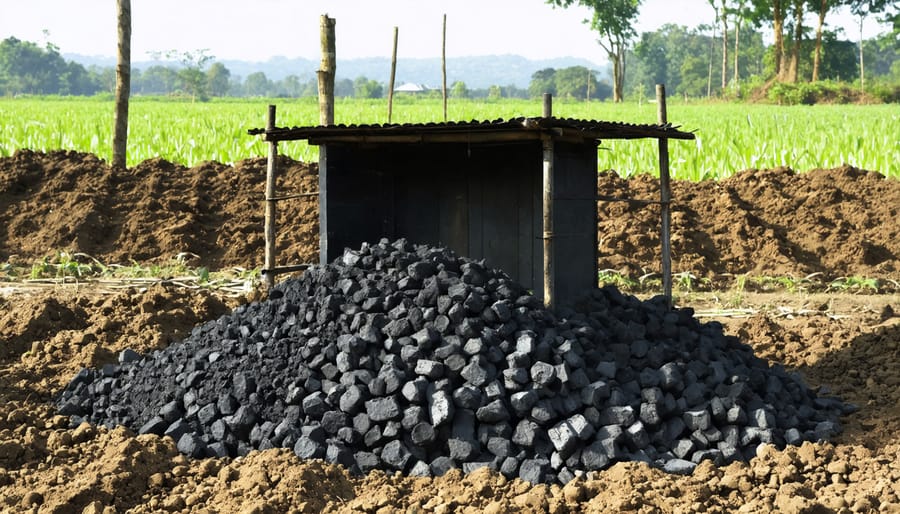
Safety and Quality Control
When producing biochar for agricultural use, following proper safety protocols and quality standards is crucial. Always wear appropriate personal protective equipment, including heat-resistant gloves, safety goggles, and respiratory protection, especially during the production process when smoke and particulates may be present.
Quality control starts with selecting appropriate feedstock materials. Agricultural residues and wood waste should be clean, properly dried, and free from contaminants like plastics or treated lumber. Monitor production temperatures, which should typically range between 350-600°C for optimal biochar properties.
The Canadian Organic Standards recognize biochar as an approved soil amendment when produced following specific guidelines. Regular testing of your biochar is recommended to ensure it meets these standards, particularly for pH levels, carbon content, and potential contaminants.
Store finished biochar in a dry, covered area to prevent moisture accumulation and potential dust issues. When applying biochar to fields, use dust suppression methods like light water spraying or mixing with compost before application. Consider working with local agricultural extension services to verify your biochar meets regional safety requirements and quality benchmarks.
As we’ve explored throughout this article, biochar soil amendment presents a promising opportunity for Canadian farmers to enhance soil health while contributing to sustainable agriculture practices. The evidence from Alberta farm trials shows that biochar can increase crop yields by 15-30% while improving soil water retention and reducing fertilizer needs by up to 25%.
Moving forward, implementation of biochar practices doesn’t have to be overwhelming. Start small by testing biochar on a portion of your land, perhaps 1-2 hectares, to observe its effects in your specific soil conditions. Consider joining local agricultural cooperatives or forming partnerships with neighboring farms to share equipment and knowledge, making the initial investment more manageable.
Remember that success with biochar depends on proper application rates (typically 5-10 tonnes per hectare) and integration with existing soil management practices. The Agricultural Research and Extension Council of Alberta offers support services and can connect you with experienced biochar users in your region.
The future of Canadian agriculture lies in sustainable practices that benefit both farmers and the environment. By incorporating biochar into your soil management strategy, you’re not just improving your farm’s productivity – you’re participating in a community-wide movement toward more resilient and sustainable farming practices.
For those ready to take the next step, reach out to your local agricultural extension office or join one of the many biochar workshops offered throughout Alberta. Together, we can build healthier soils for future generations.

